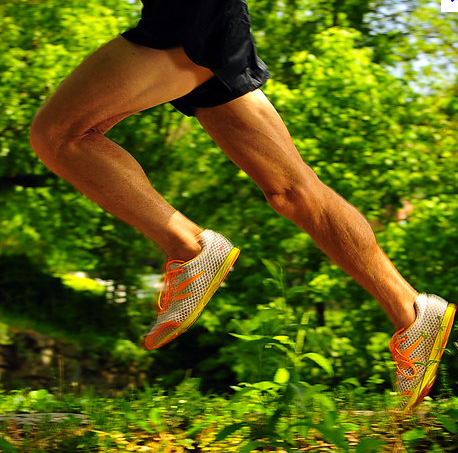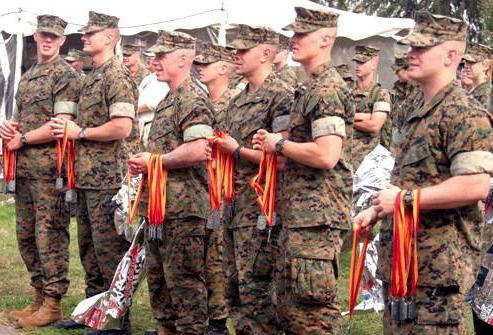 It’s a dilemma and challenge for many marathon runners. You have two important races that are only six weeks apart, and you want to perform well in both. Several weeks ago, I placed tenth overall in the Air Force Marathon. But come next weekend, I will be racing in the Marine Corps Marathon along with 30,000 other runners!
It’s a dilemma and challenge for many marathon runners. You have two important races that are only six weeks apart, and you want to perform well in both. Several weeks ago, I placed tenth overall in the Air Force Marathon. But come next weekend, I will be racing in the Marine Corps Marathon along with 30,000 other runners!
I’ve done this “double marathon” for 10 years with good success — 3 Masters wins at Marine Corps and 2 overall Air force wins. All times between 2:30 and 2:45. Weather conditions and now age dictate the times a bit as the drift is now toward 2:40 range as I turn 46. And as a Lt. Col. in the U.S. Air Force, I have been an Air Force Marathon Team Member since 1988. This will be my 20th Marine Corps Marathon.
So what are some recommendations to make a healthy transition and recovery following the first race and be ready for the subsequent one? Here’s what has worked for me in the past:
1. Eat real well after your first marathon. I’m talking steak, good beer, healthy fats and proteins as well as the good carbs.
2. “Jog” ridiculously easy until you feel the “spring” or “pop” back in your legs. Most know what this is and there is no measurement on any tech device. This is when you wake up in the morning and are not stiff. The run feels quick and springy as it should. This usually takes at least 3-5 days. If you force fast or hard running before you feel this you are delaying recovery.
3. Restart quality endurance first at an easy pace. For example, several weekend ago, I did a really mellow 2-hour run to keep the aerobic engine tuned but it was slow, but had a purpose of aerobic stimulus.
4. The other day, I finally felt “springy” and flew with an early morning tempo run. I was waiting for this feeling to come back and it did.
5. I then begin adding quality endurance work and tune ups to be fresh and ready for the Marine Corps Marathon.
***
Last year, I wrote a piece on racing well in the Marine Corps Marathon, and can help you better perform in all marathons. It’s reposted below:
Semper Fly in the Marine Corps Marathon
 As you enter the week prior to the race here are a few visualizations to help you set your plan. Running your best marathon is part art, science, guts, faith in what you can do, and a little luck. Running your best 10k is mostly about fitness. The best analogy I can think of is this: if you have trained your body properly with the right mix of aerobic level training and some up tempo stuff in recent weeks, you have built your efficient hybrid engine ready to race the marathon. Many of you have driven in a Prius and watch the subtle shifts between gas and electric on the screen. You do not perceive these shifts. Your engine runs on gas, electric, or a mix- depending on the effort.
As you enter the week prior to the race here are a few visualizations to help you set your plan. Running your best marathon is part art, science, guts, faith in what you can do, and a little luck. Running your best 10k is mostly about fitness. The best analogy I can think of is this: if you have trained your body properly with the right mix of aerobic level training and some up tempo stuff in recent weeks, you have built your efficient hybrid engine ready to race the marathon. Many of you have driven in a Prius and watch the subtle shifts between gas and electric on the screen. You do not perceive these shifts. Your engine runs on gas, electric, or a mix- depending on the effort.
You are starting the race with one gallon in the tank- assuming you have eaten a nice meal the night before with a breakfast top off.
• If you are in all gas mode, your engine will run about 1.5 hours at a strong pace….then you are out of gas.
• If you are mostly electric you can run all day, but maybe maybe not so quickly.
• If you are using the proper mix you will go quick and efficient for duration of your event, and you can even do some topping off along the way.
The glucose utilizing pathway is the gas. This is your stored glycogen and blood glucose (pasta meal and breakfast) – easy to access for ready energy. The fat utilizing pathway is the electric. In marathons you must be in hybrid until the last few miles. Hybrid is where your energy is coming from both sources.
Many runners are in great “10k shape” (an all gas event), then run their marathon in the gas mode- and usually crash. Glycogen sparing strategy need not apply in races of less than an hour as long as you had a good pre-event meal to fill the tank. In marathons and ultras- top end fitness matters little and can only be applied very near the finish. Glucose gives 36 ATP per molecule, fat 460 ATP per molecule. You must tap into the fat burning tank. Now you know how a bird can migrate 7000 miles without an energy bar.
So how do you know you are running in your best hybrid mode?
This is difficult because the sense is not as profound as aerobic/anaerobic. A slight increase from your optimal pace will switch you from hybrid to all gas without you realizing it, and the effects are felt miles later. Charging up hills early will tap your gas quickly. If you want to speed up early…don’t. Relax and maintain effort, not speed.
You must rehearse a bit in training. I focus on relaxation and breathing. If I’m breathing one cycle to 5 steps, then I’m hybrid. If I’m breathing faster I’m using mostly glucose as fuel. Belly breathe- allow lower belly to blow up like a beach ball on inhalation and pull your belly button back to your spine on exhalation. Then you will fill the lower lung areas where oxygen exchange occurs. Notice the breathing efforts of those around you and many are rapid breathing- they tend to suffer somewhere past half way. Rehearse complete relaxation from the top down- eyes, jaw, shoulders, allow your legs to relax and extend behind you, relax and soften your knees and ankles. Find you own cue for this. If you use the Heart Rate Monitor in training strongly consider one during the event.
In a marathon, the last 3-4 miles you will be all gas to maintain the same speed as fatigue sets in. The breathing is usually on a 3 to 4 steps per breath cycle- that is OK. Still stay relaxed and use the cues that you have rehearsed to keep your form. Your heart rate is higher now. Speed up only when you can “smell the barn”, maybe after 20 miles.
Land softly, especially on the early downhills. I run with a forefoot/midfoot landing harnessing elastic recoil. Focus on posture and hip extension. Use a slight forward lean from the ankles. I’m never sore after marathons now and feel I can keep doing them until I enter the retirement home. I won the Air Force Marathon in 2:38 four weeks ago and feel fine now for another effort. With good form it is “No pain…thank you”.
Have a course specific plan. For the Marine Corps Marathon this is pretty simple. Relax on the first uphill section, relax on the slightly rolling ups and downs from miles 4-8 around the Georgetown Reservoir. Relax and enjoy the tour through the Mall. Relax and find a nice rhythm on the peaceful stretch around Haines Point. This is actually my favorite part of the race. There are no distractions, just peace in the moment. You get it now–the art of a marathon is to relax and be in the moment. Rehearse relaxing head to toe and use the belly breathing.
Save energy for the 24th Bridge, this is where things can get tough. Two miles of lonely cement and often into the wind. As you exit the Bridge and enter Crystal City, if you feel really good then is it time to take some chances and charge. Remember, if you feel really good in the early stages and feel like you want to speed up….don’t. It is a marathon and you should feel good in the early miles.
Your shoes matter too. Not that you are going to change your shoes in the next day based on my advice, but make strong consideration to not running in minimalist racing flats, unless you have trained substantially in them and adapted to a natural barefoot style gait. I advocate gradually adapting all of your training in the more minimal and level shoes. If you relax your lower legs and load the springy tendons in your feet and Achilles, then these shoes with no heel elevation put you in perfect position to allow natural elastic recoil of plantar fascia, Achilles, calf muscles, and hip flexors.
New research and runner’s experience is now making the case for running with a more efficient stride and questions modern running footwear. The evolving world of modern sports medicine is going back to the future too and rediscovering what evolution has taught us.
Now a few extra ways to get from start to finish quicker on the same gallon.
• If you can add a little gas along the way then you can go more into gas mode. This works a little at best. If running too fast you shunt all blood to working muscles and nothing digests. If you are in hybrid the early going you can continually add fuel- the key is not only the correct fuel, but the right pace. An energy gel every 25 minutes is easy to digest and tops off the tank. Carry them with you at the start. The weight is nothing compared to the benefit you will get. If you do the gels then you can drink water instead of the energy drinks which are often less predictable on the run. Marine Corps has a gel station at Mile 9, 13, and 23. Carry 2 gels at the start (one every 3-4 miles or so) and top-off along the way.
• Maintain effort on uphill. Your pace will slow. You can easily use all your gas here if your effort increases. Shorten your stride, relax, and use your arms. Then allow gravity to take you down. The first hills in Arlington and Georgetown can feel “easy” but if run too hard can drain your gas quickly; so go easy up them.
• If it is windy get behind a group. This can save lots of physical and mental energy.
• If you are having a “bad patch” – try to refocus on relaxing, fuel a bit (sometimes a blood glucose drop triggers the sense of doom), and have faith in your training and race plan. Another nice trick is when you hit mile 21 it is not 5 miles to go, it is 4 and change. Mile 22 is 3 and change to go. Just run to the next mile marker and count them down one by one. Smile and enjoy the party in Crystal City. This gives you some mental refreshment after crossing the lonely bridge from 20-22 miles.
• Do not over drink water. This can lead to a dangerous condition called hyponetremia and severe electrolyte imbalance.
The fun of the marathon is that we are always learning and enjoying the adventure of it. I’ve done over 70 marathons now with a couple under 2:25 in my younger years.
We learn from experience, taking chances, and occasional failures. My first marathon was the 1988 Marine Corps, and I went 2:34. That was also a time when I could run about 30 minutes for 10K. Nearly a quarter-century later, I hope to get near this time again, even though my current 10K time is about 35 minutes. I’ve learned a few things in all these years on how to train and race efficiently and economically; but still there are uncertainties every time you line up. So relax, taper, and seize the day.
Finally, I’d like to especially thank all the Armed Forces Members around the world who sacrifice daily in the service of their country and for all the volunteers who make the Marine Corps Marathon an incredible event. tThank the Marines you see around the course and that in itself will give you added spirit.
***
The Big Debate
On the Saturday before the Marine Corps Marathon I will be speaking at an important sports medical conference hosted by theAmerican Medical Athletic Association (AMAA.) My talk about “Footwear and Running” directly follows a talk by Simon Bartold, of ASICS Research, whose topic is “Barefoot Running and Minimalism: The Big Questions.” Afterwards, we will have a spirited debate. Although we may not agree about footwear, we both just want to keep folks running healthy. There’s still a chance to attend, and I urge all health professionals to come! Go here for more details: http://www.amaasportsmed.org/meetings/AMAA_MCM2012.htm


Hello Dr. Mark,
Excellent article. I am looking for advice on marathon footwear. Ive run barefoot and minimalist for years now and will never look back. However I am currently training for a marathon and I am beginning to have problems with the balls of my feet getting sore around the ten mile mark. I am running in F-lite 195s which normally work very well but I have rarely exceeded 5 to 6 miles on asphalt or concrete before this. Do you recommend minimalist shoes for marathon? If you do how do you deal with the sore feet?